Yankee Stadium and Monument Park
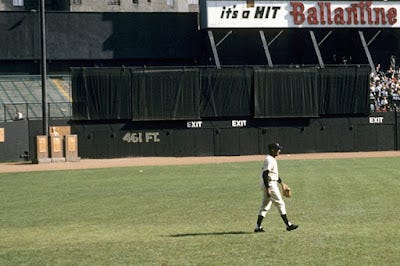
Baseball legends were remembered in this piece of Yankee Stadium real estate, a tradition continued today in the ballpark’s namesake.
by Rich Watson
Yankees manager Miller Huggins died of a form of blood poisoning on September 25, 1929 at age fifty. The former Red and Cardinal led Babe Ruth’s squad to three championships. The American League cancelled its schedule the day of his funeral and the World Series observed a moment of silence for him.
Three years later, in his honor, the Yankees built a granite slab with his image and accomplishments inscribed on it in bronze. They placed it in front of the center field flagpole at Yankee Stadium for all to see and remember. Its inscription calls him “a splendid character who made priceless contributions to baseball.”
When Ruth and Lou Gehrig died in the forties, similar markers joined the one for Huggins. They formed the foundation of a memorial unique in all of sports, one that could only have come from the House that Ruth built.
The original Yankee Stadium, in a nutshell
Since 1913, the Yankees had lived in the Polo Grounds with the Giants. They were sick of it, and the feeling was mutual. When they acquired Ruth in 1920 they outdrew the Giants in their own park, but in 1921-22 the Giants beat them in consecutive World Series.
Finally the Yankees built a place of their own. Their new ballpark was across the Harlem River in the Bronx, on the corner of East 161st Street and River Avenue, within sight of the Polo Grounds. It was the first ballpark with three tiers, earning the name “stadium.”
In its first season, 1923, the Yankees returned to the series for a third year in a row. This time they beat the Giants, the first of twenty-seven championships—twenty-six of which were in the old Stadium.
The Stadium had that shallow right field—296 feet down the first base line—to make hitting homers easier for Ruth.
Center field was nicknamed “Death Valley” on account of its great distance. The number in the photo at the top of the page is not a manipulation; in fact, center used to be deeper than that. The park’s dimensions changed over the years.
The football Giants played there from 1956-73 (they won a title in 1956) as did college football teams such as Notre Dame and Army.
It had soccer, hockey and boxing matches, including the 1938 Joe Lewis fight against the German Max Schmeling (yes, Hitler was a fan).
There were concerts and religious events, like visits from the Pope.
In 1990, Nelson Mandela stopped by.
On September 23, 2001, the Stadium hosted a 9-11 memorial.
Gehrig, Ruth and others remembered
In 1939, Gehrig was diagnosed with an incurable neurodegenerative disease called amyotrophic lateral sclerosis, in which a loss of motor neurons weakens voluntary muscles. After a sixteen-year career with New York in which he played for 2,130 consecutive games and won the MVP award twice, Gehrig retired. His farewell speech at Yankee Stadium was one for the ages.
Two years later, he died in the Bronx at 37. His cremated ashes lay in Valhalla, NY. The center field monument to him says, “A man, a gentleman and a great ballplayer whose amazing record of 2,130 consecutive games should stand for all time.” (The fact that it didn’t stand in no way diminishes the accomplishment.)
By this time center field had diminished from 500 feet to 461.
Ruth retired as a ballplayer in 1935. Eleven years later, he was diagnosed with a form of cancer. On April 27, 1947, MLB declared Babe Ruth Day. Despite a dramatic weight loss and a gravelly voice, he appeared in Yankee Stadium to deliver a farewell speech of his own.
He died in 1948 at 53. His grave lies in Hawthorne, NY with his second wife Claire. His center field monument calls him “a great ball player, a great man, [and] a great American.” Younger fans who came to the Stadium often thought the three headstones indicated dead bodies buried in center field.
In addition to the markers for Huggins, Gehrig and Ruth, bronze plaques on the center field fence stood for former owner Jacob Ruppert (1940, after his death in 1939) and former manager and executive Ed Barrow (1954, after his death in 1953). In subsequent years, plaques for Joe DiMaggio and Mickey Mantle joined the others.
The 1974-75 renovation and Monument Park’s official opening
Yankee Stadium closed for two years in the mid-seventies for repairs. During this time the team brought center field in further, to 417 feet. This led to the creation of an enclosed area for the monuments. It also prevented incidents where the markers interfered with balls in play.
In 1985, center field shrunk further, to 410 feet, and at last, the area unofficially referred to as “Monument Park” opened to the public. When DiMaggio and Mantle died during the nineties, the Yankees built two more granite slabs and mounted their plaques onto them. No other players since have received similar markers.
Number retirements and special non-sports markers
Monument Park has also become a place to display the Yankees’ many retired numbers. The team will add Paul O’Neill’s 21 this August.
The park also honors certain luminaries and events:
Broadcaster Mel Allen, public address man Bob Sheppard and owner George Steinbrenner are honored with plaques.
Jackie Robinson’s 42 is retired, as it is throughout all of MLB. In the Yankees’ case, it’s retired twice; Mariano Rivera was the last Yankee to wear it.
The Knights of Columbus commissioned plaques in honor of three papal visits: Pope Paul VI in 1965, Pope John Paul II in 1979 and Pope Benedict XVI in 2008.
There is a 9-11 memorial from 2002,
a Mandela one from 2014 following his death, and
one from 2019 to observe the fiftieth anniversary of the gay rights uprising at the Stonewall Inn bar.
The modern Yankee Stadium
Even after the 1974-75 renovations, Yankee owner Steinbrenner craved additional changes. For decades, he had threatened to move the team to New Jersey unless New York City provided a new stadium.
In 2006, after some more World Series wins, the city gave in. Ground broke on a new ballpark adjacent to the original. It opened three years later, at a cost of $2.3 billion—$1.2 billion of that in public subsidies.
The new Monument Park lies behind center field and below a sports bar. The five granite markers hold pride of place in the middle.
As for the old Yankee Stadium…
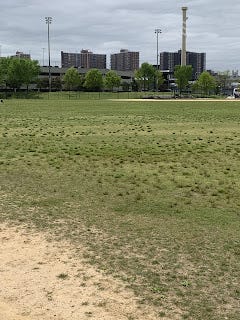
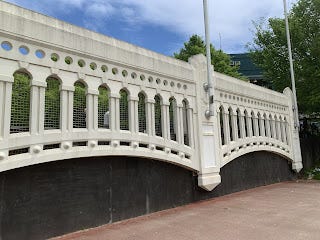
…the original stadium was demolished. The field was converted into a little league site called Heritage Field.
————————
Last-minute post-script: Two weeks ago, my friend Betsy had an extra ticket to a Yankee game, at the new Stadium. It was only the second time in my life I had ever been to a Yankee game. The first time, the team still had Mattingly and Winfield and Randolph.
The new Monument Park was the shrine I expected it was, not just to the Yankees but, in a way, to modern American history. I wish I had seen the original in person.
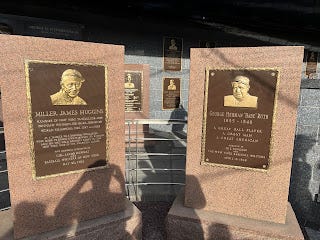
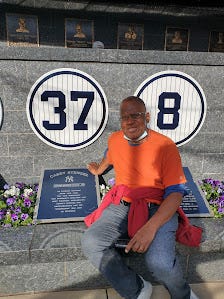
———————
Have you been to either version of Monument Park?


